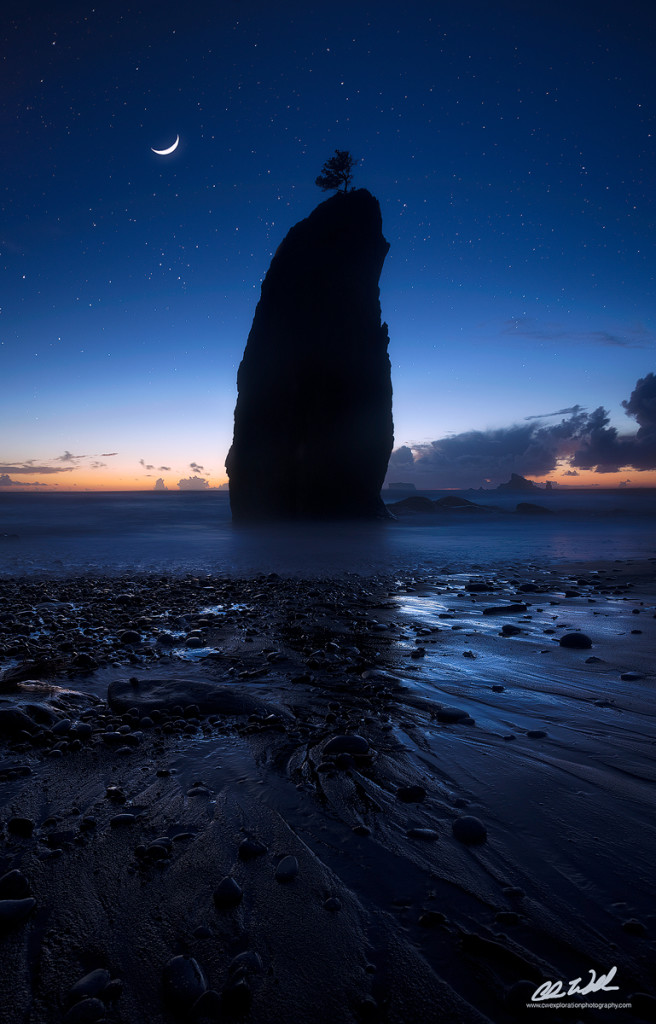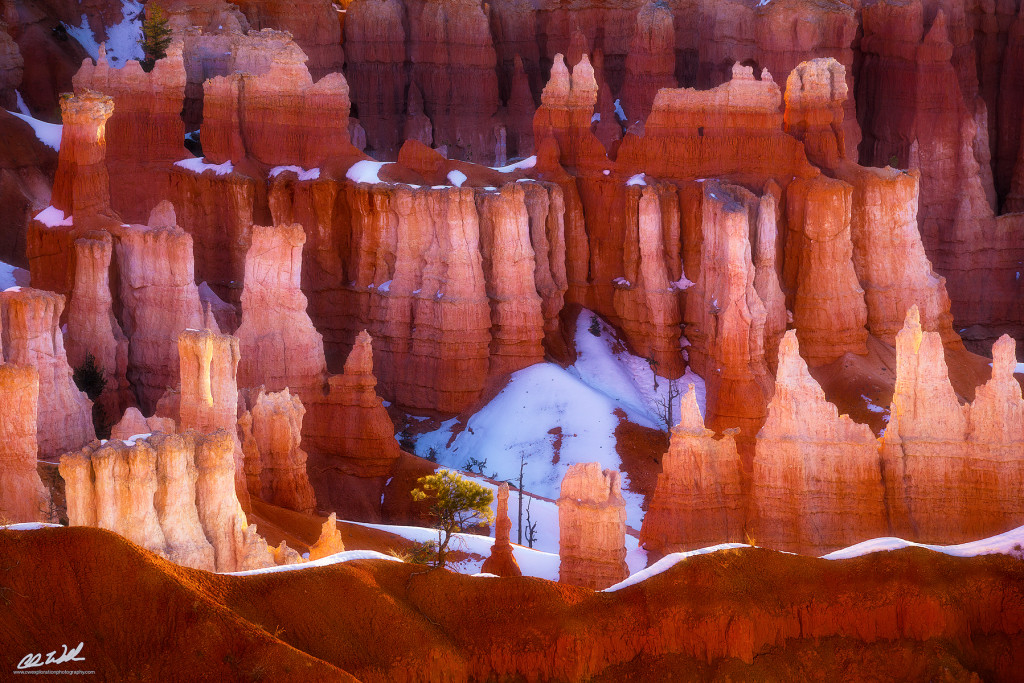Compositional Visualization: See the ball, be the ball
Developing an eye for composition in landscape photography is something that takes a great deal of time and practice in the field. Sure, some folks don’t have to work as hard but you’ve got to put the hours in behind the lens to really gain a solid understanding of what elements make for a strong composition. I can’t tell you how many times early in my career I completely botched a composition or just missed the mark all together. One thing that I’ve learned over time is that you absolutely have to pre-visualize your shot. How do you want to process it? What elements do you want in the scene? Where are your foreground elements? Leading lines? Focal point? What direction is the light entering your frame? Does it work? Does your composition look balanced? Do you have complementary colors throughout the image? Is there symmetry or are there patterns present? Is the image interesting? These are all quest ions that constantly fill my head when I’m in the field. Now the question I’m sure you’re asking is “How in the world do I do that when everything is changing, the conditions are deteriorating and the good light is slowly burning out??”
ions that constantly fill my head when I’m in the field. Now the question I’m sure you’re asking is “How in the world do I do that when everything is changing, the conditions are deteriorating and the good light is slowly burning out??”
I know it sounds complicated but I promise you; it’s not nearly as bad as it seems. Pre visualizing the shot starts with four key elements – the direction of the light, the focal point, the foreground and the leading line(s). The focal point is often the first thing that your eye gravitates toward. It could be a waterfall, a mountain or even a stand of trees. If your eye gravitates toward it chances are it may serve as a good focal point to build your composition around. The next step in the process is to look for a leading line that guides your eye through the scene to your focal point.
The ‘line’ is figurative of course. It can be a rock formation, a river, a series of interesting trees, vegetation or foliage, flowers, or even a trail. Choosing the correct leading line can have a large impact on your image. It is important to note though that the leading line may not work depending upon the direction of the light in the scene. All of the elements need to work together to form a pleasing composition. Let the light guide your eye to the focal point in the image. Shadows and light play a huge role in guiding your eye through the scene and, when used correctly, can add a great deal of depth and interest to your photo. Choosing the correct foreground (FG) can have a large impact on the success of your image. I always try to choose a FG that offers a complementary color palette to the other elements in the scene such as the sky or mountains. Ted Gore published an excellent article on color theory so I won’t get too far into it here. It’s safe to say that utilizing color theory correctly can really have a profound effect on the outcome of your image.
Texture and Layers
Texture is not something that’s often discussed in composition but I think that it’s crucially important to strengthening your composition. Water texture is a solid example of this. In some cases, soft water texture will work extremely well to give an image full of elements with an abundance of harsh textures such as rock and sand a more dynamic and ying/yang feel. Texture can also convey a nice sense of movement as well. Taking a shorter exposure of water for instance can add a great deal of movement to the scene. Balancing texture can be tricky but very useful. I personally like to include elements that offer a variety of textures that work well together. For instance; if you’ve got a series of jagged mountain peaks with clouds that lack interest try using a long exposure to convey movement and add a soft blurred look in the sky to contrast the sheer rock and ice. 
Utilize vegetation such as ferns, flowers or trees to add a contrast in texture to elements such as smooth rock, sand, fog or snow. One of the reasons that foggy tree shots tend to work so well is the play on not only contrast but textures as well. The jagged trees jutting out through the smooth rolling clouds and fog add a ton of interest to the image. Texture can also be useful in setting up leading lines in a photograph. It can add depth, help with framing and ultimately solidify an already strong composition. Pay attention to the textures that are in the vicinity of where you’re shooting. Look for ways to bring them into the scene to add balance and interest. The addition of texture, if used correctly, can draw your viewers into your image and ultimately help to shape the overall delivery of your work.
Layering on the other hand is a very popular theme in landscape photography- composing an image to bring layers and depth into the frame can add a lot of interest to your photo and can make it stand out from the crowd. I always try to add a bit of layering in my composition- even clouds and fog can add depth and interest. One way to go about doing this is to shoot in portrait mode. Shooting in portrait mode can compress the composition and can add depth by compressing the foreground, middle ground and background into ‘layers’. The other way to do this is to use longer lenses and telephoto work can often compress the scene and achieve some of the same things goals mentioned above.
Go wide or go home, right?
In truth this is a very loaded discussion, but if you’ve been paying attention to trends in landscape photography you will have seen a slight shift toward subtle, intimate and sometimes abstract scenes shot at longer focal lengths. Shooting landscape images with long lenses (focal lengths that range anywhere between 70-400mm+) can be very challenging but a lot of the same aspects of shooting grand scenes can still be applied in many ways. Layering, light, leading lines, patterns, color profiles and a focal point all play a huge part in making a smaller scene seem grand and inviting. Balancing these elements can be tricky given the constraints that a longer focal length can impose but the rewards can be plentiful!
When shooting scenes such as this, one of the first things I look for is depth followed by layering, framing and light. If you see a focal point or a subject that looks amazing but lacks a solid foreground or is minimized a great deal by a wide angle lens, then you may want to switch things up and go for a longer focal length. Zooming in on your subject can dramatically change the way the scene looks i.e. the presentation of light and contrast, the depth and the overall feeling that the image may convey. Shooting longer focal lengths can also take a well known scene and transform it into something that almost renders it unrecognizable even to frequent visitors.
In the field I often mount the telephoto lens/camera combo on my tripod and pan throughout the scene using your viewfinder as a guide. If you see something that really captures your eye or that you find yourself going back to snag an image of it! Don’t be afraid to experiment; play with the different focal lengths available to you. Zoom in and out on a subject to see what looks best. Take multiple image s of the same subject at different focal lengths; you may find that one works overwhelmingly better when you begin your editing process and trust me you will kick yourself if you don’t have options to look at.
s of the same subject at different focal lengths; you may find that one works overwhelmingly better when you begin your editing process and trust me you will kick yourself if you don’t have options to look at.
Information Overload
Personally, I think that one of the biggest issues that landscape photographers face in the field is information overload. I think it’s happened to everyone at some point in their photographic careers. It’s the point when you arrive at a location that you didn’t have time to scout, the light is going off and you’re completely overwhelmed. You know you’ve got to nail down a strong composition in a short amount of time but where to do you even start? No pressure at all, right? First things first; breathe! Take a deep breath and take in the scene. Where’s the light coming from? What focal point does your eye focus on?
Break down the scene and put it back together; does it have nice flow? Does the sum of the parts contribute to the whole? Don’t get fixated on one solid composition. Look for alternatives. Take your camera off of the tripod and look through the viewfinder or use live-view. Move around and get a quick feel for the different options that the scene may provide. When I’m trying to determine how to put my composition together I look for depth, layering, curves and strong points of interest to guide my eye through the frame. Remember that there are no rules in art, as in photography. Placing constraints around your style and vision will only serve to hinder your personal development as a photographer and an artist.
Final Thoughts on Composition
 In the end you are the artist and the photographer. Be inspired by others but also develop your own unique style and eye for composition. Imitation is a form of flattery but at what cost to your own creative process? We are bombarded with inspirational content on what seems to be a weekly if not daily basis. Learn from the images you see but don’t limit yourself to their constraints. Find your own voice in composition and you will succeed.
In the end you are the artist and the photographer. Be inspired by others but also develop your own unique style and eye for composition. Imitation is a form of flattery but at what cost to your own creative process? We are bombarded with inspirational content on what seems to be a weekly if not daily basis. Learn from the images you see but don’t limit yourself to their constraints. Find your own voice in composition and you will succeed.

2 Comments
Nice write-up Chris, and a lovely page. I agree with everything. I personally don’t see much room for arguing that great landscapes can be had at every conceivable focal length you can realistically use. I stress your last point a lot in my blog posts, and even recommend novices and learning photographers to completely eliminate online browsing of images, until you develop your own style and vision. I know nobody will actually do this, but it’s how I came to be a photographer and I can’t see that I’d be the same if I would’ve learned in the age of social media. I’d be more derivative for sure. Great work!
Thanks for taking a few to read it, Michael! I definitely agree; I think we should never limit ourselves to a certain focal length or style of shooting. In hindsight social media may have hindered my creative style early on but I think in the bigger picture it’s actually helped me to think more outside of the box and to really get a feel for what defines my particular style of shooting.